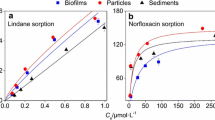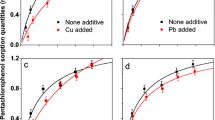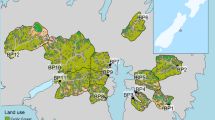Abstract
The effect of phototrophic biofilm activity on advective transport of cadmium (Cd), copper (Cu), nickel (Ni), and lead (Pb) in sandy sediments was examined using percolated columns. Cd and Ni in the effluent exhibited clear diel cycles in biofilm-containing columns, with concentrations at the end of dark periods exceeding those during illumination by up to 4.5- and 10-fold for Ni and Cd, respectively. Similar cycles were not observed for Pb or Cu. Breakthrough of the latter metals was greatly retarded and incomplete relative to Cd and Ni, and trends in biofilm treatments did not differ greatly from those in control columns. Inhibition of photosystem II by DCMU (3-(3,4-dichlorophenyl)-1,1-dimethylurea) proved that diel cycles of Cd and Ni were controlled by oxygenic photosynthesis, and microsensor measurements showed that metal cycles closely matched metabolic activity-driven pH variations. The sorption edge pH for the sand/biofilm substrate followed the order Ni > Cd > Cu > Pb, and for Ni and Cd, was within the pH 7–10 range observed in the biofilm-containing column. Adsorption dynamics over the light periods matched pH increases, but desorption during dark periods was incomplete and slower than the rate of change of pH. Over a diel cycle, desorption was less than adsorption, resulting in net binding of dissolved metals due to the biofilm metabolic activity. Extraction with selective reagents indicated that the adsorbed metals were readily exchangeable, and potentially bioavailable. Thus, phototrophic benthic biofilms can control the transport of some metals across the sand–water interface, and processes in this very thin surficial layer should be considered when evaluating chemical fluxes in permeable sediments.










Similar content being viewed by others
References
Battin TJ (2000) Hydrodynamics is a major determinant of streambed biofilm activity: from the sediment to the reach scale. Limnol Oceanogr 45(6):131–1308
Beck AJ, Janssen F, Polerecky L, Herlory O, de Beer D (2009) Phototrophic biofilm activity and dynamics of Diurnal Cd cycling in a freshwater stream. Environ Sci Technol 43:7245–7251
Benjamin MM, Leckie JO (1981) Multiple-site adsorption of Cd, Cu, Zn, and Pb on amorphous iron hydroxide. J Colloid Interface Sci 79(1):209–221
Berner RA (1980) Early diagenesis: a theoretical approach. Princeton University Press, Princeton, 241 pp
Burnett WC, Bokuniewicz HJ, Huettel M, Moore WS, Taniguchi M (2003) Groundwater and pore water inputs to the coastal zone. Biogeochemistry 66:3–33
Charette MA, Sholkovitz ER (2006) Trace element cycling in a subterranean estuary: part 2. Geochemistry of the pore water. Geochimica et Cosmochimica Acta 70(4):811–826
Cook PLM, Røy H (2006) Advective relief of CO2 limitation in microphytobenthos in highly productive sandy sediments. Limnol Oceanogr 51(4):1594–1601
Coynel A, Schäfer J, Dabrin A, Girardot N, Blanc G (2007) Groundwater contributions to metal transport in a small river affected by mining and smelting waste. Water Res 41:3420–3428
Davidson CM, Duncan AL, Littlejohn D, Ure AM, Garden LM (1998) A critical evaluation of the three-stage BCR sequential extraction procedure to assess the potential mobility and toxicity of heavy metals in industrially-contaminated land. Anal Chim Acta 363:45–55
Dzomback DA, Morel FMM (1990) Surface complexation modeling: hydrous ferric oxide. Wiley-Interscience, New York
Ehrenhauss S, Witte U, Bühring SI, Huettel M (2004) Effect of advective pore water transport on distribution and degradation of diatoms in permeable North Sea sediments. Mar Ecol Prog Ser 271:99–111
Fuller CC, Davis JA (1989) Influence of coupling sorption and photosynthetic processes on trace-element cycles in natural waters. Nature 340(6228):52–54
Fuller CC, Harvey JW (2000) Reactive uptake of trace metals in the hyporheic zone of a mining-contaminated stream, Pinal Creek. Ariz Environ Sci Technol 34:1150–1155
Gieseke A, de Beer D (2004) Use of microelectrodes to measure in situ microbial activities in biofilms, sediments, and microbial mats. In: Kowalchuk GA, de Bruijn FJ, Head IM, Akkermans AD, van Elsas JD (eds) Molecular microbial ecology manual. Kluwer, Dordrecht, pp 1581–1612
Gonzalez-Davila M (1995) The role of phytoplankton cells on the control of heavy metal concentration in seawater. Mar Chem 48:215–236
Huettel M, Ziebis W, Forster S (1996) Flow-induced uptake of particulate matter in permeable sediments. Limnol Oceanogr 41(2):309–322
Huettel M, Ziebis W, Forster S, Luther GW III (1998) Advective transport affecting metal and nutrient distributions and interfacial fluxes in permeable sediments. Geochim Cosmochim Acta 62(4):613–631
Kloep F, Röske I (2004) Transport of algal cells in hyporheic sediments of the River Elbe (Germany). Int Rev Hydrobiol 89:88–101
Langmuir D (1997) Aqueous environmental geochemistry. Prentice-Hall, New Jersey
Maes A, Cremers A (1975) Cation exchange hysteresis in montmorillonite a pH-dependent effect. Soil Sci 119: 198–202
Martin JM, Nirel P, Thomas AJ (1987) Sequential extraction techniques: promises and problems. Mar Chem 22:313–341
Morris JM (2005) Mechanisms and effects of light-mediated zinc uptake by photosynthetic biofilm: implications for diel metal cycling in mining-impacted streams, PhD Thesis, University of Wyoming
Morris JM, Meyer JS (2007) Photosynthetically mediated Zn removal from the water column in High Ore Creek, Montana. Water Air Soil Pollut 179(1–4):391–395
Morris JM, Nimick DA, Farag AM, Meyer JS (2005) Does biofilm contribute to diel cycling of Zn in High Ore Creek, Montana? Biogeochemistry 76:233–259
Morris JM, Farag AM, Nimick DA, Meyer JS (2006) Light-mediated Zn uptake in photosynthetic biofilm. Hydrobiologia 571:361–371
Mutz M, Rohde A (2003) Processes of surface-subsurface water exchange in a low energy sand-bed stream. Int Rev Hydrobiol 88(3–4):290–303
Nimick DA, Gammons CH, Cleasby TE, Madison JP, Skaar D, Brick CM (2003) Diel cycles in dissolved metal concentrations in streams: occurrence and possible causes. Water Resour Res 39(9). doi:10.1029/2002WR001571
Padmanabham M (1983) Comparative study of the adsorption-desorption behavior of copper(II), zinc(II), cobalt(II) and lead(II) at the goethite-solution interface. Aust J Soil Res 21:515–525
Precht E, Franke U, Polerecky L, Huettel M (2004) Oxygen dynamics in permeable sediments with wave-driven pore water exchange. Limnol Oceanogr 49(3):693–705
Quevauviller Ph, Rauret G, Griepink B (1993) Single and sequential extraction in sediments and soils. Int J Environ Anal Chem 51:231–235
Rauret G, López-Sánchez JF, Sahuquillo A, Rubio R, Davidson C, Ure A, Quevauviller Ph (1999) Improvement of the BCR three step sequential extraction procedure prior to the certification of new sediment and soil reference materials. J Environ Monit 1:57–61
Revsbech NP, Jørgensen BB (1986) Microelectrodes – their use in microbial ecology. Adv Microb Ecol 9:293–352
Riedl R, Huang N, Machan R (1972) The subtidal pump: a mechanism of intertidal water exchange by wave action. Mar Biol 13:210–221
Shaw RD, Prepas EE (1990) Groundwater lake interactions. 2. Nearshore seepage patterns and the contribution of ground-water to lakes in central Alberta. J Hydrol 119(1–4):121–136
Stein J (ed) (1973) Handbook of phycological methods. Culture methods and growth measurements. Cambridge University Press, New York, 448 pp
Strawn DG, Scheidegger AM, Sparks DL (1998) Kinetics and mechanisms of Pb(II) sorption and desorption at the aluminum oxide-water interface. Environ Sci Technol 32:2596–2601
Stumm W, Morgan JJ (1996) Aquatic chemistry. Wiley, New York, 1022 pp
Tessier A, Campbell PGC (1991) Comment on “Pitfalls of sequential extractions” by P. M. V. Nirel and F. M. M. Morel. Water Res. 24:1055–1056 (1990); Water Res 25(1): 115–117
Thibodeaux LJ, Boyle JD (1987) Bedform-generated convective transport in bottom sediment. Nature 325:341–343
Tomaselli L, Lamenti G, Tiano P (2002) Chlorophyll fluorescence for evaluating biocide treatments against phototrophic biodeteriogens. Ann Microbiol 52:197–206
Triska FJ, Duff JH, Avanzino RJ (1993) The role of water exchange between a stream channel and its hyporheic zone in nitrogen cycling at the terrestrial aquatic interface. Hydrobiologia 251(1–3):167–184
Woodruff SL, House WA, Callow ME, Leadbeater BSC (1999) The effects of biofilms on chemical processes in surficial sediments. Freshw Biol 41:73–89
Acknowledgements
Funding for this study was provided by the ECODIS project (European Commission’s 6th framework program, subpriority 6.3 “Global Change and Ecosystems,” under contract 518043). We greatly appreciate assistance with microsensor construction from the Microsensor Group technicians: I. Dohrmann, G. Eickert, K. Hohmann, A. Niclas, I. Schröder, and C. Wiegand. We also wish to thank Silvana Pape (U. Bremen) for ICP-OES assistance. This manuscript benefitted from comments by two anonymous reviewers.
Author information
Authors and Affiliations
Corresponding author
Rights and permissions
About this article
Cite this article
Beck, A.J., Janssen, F. & de Beer, D. The influence of phototrophic benthic biofilms on Cd, Cu, Ni, and Pb transport in permeable sediments. Biogeochemistry 102, 167–181 (2011). https://doi.org/10.1007/s10533-010-9429-2
Received:
Accepted:
Published:
Issue Date:
DOI: https://doi.org/10.1007/s10533-010-9429-2




